Gapsagyegok Valley (갑사계곡)
415.6M 2024-02-21
519 Gapsa-ro, Gyeryong-myeon, Gongju-si, Chungcheongnam-do
Gapsagyegok Valley is a valley located on the northwest slope of Gyeryongsan Mountain in Gongju-si. With moderate temperatures even in summer, it is suitable as a recreational area, while the autumn foliage adds to its beauty. At the entrance lies Gapsa Temple, a Buddhist temple with various cultural assets, offering insights into Korean Buddhist culture. Within the valley, visitors can enjoy forest walks and view attractions such as the Yongmunpokpo Falls.
Gapsa Temple (갑사)
1.0Km 2021-12-17
567-3, Gapsa-ro, Gongju-si, Chungcheongnam-do
+82-41-857-8981
Gapsa Temple is located in the forested foothills of Gyeryongsan Mountain, 19 kilometers from Gongju and a three-hour walk from Donghaksa Temple. The temple is most beautiful during fall when surrounded by crimson foliage. Gapsa Temple was established by monk Adohwasang in 420, during the early Baekje Period. The temple's beauty allowed it to escape destruction many times, but it was ultimately burned down during the Imjin War (1592-1598). The current structures were built in 1604. Nearby attractions include Yongmunpokpo Falls, Sujeongbong Peak, and Cheonjinbotab Pagoda.
Gyeryongsan Ceramics Village (계룡산도예촌)
3.9Km 2025-02-04
71-25 Doyechon-gil, Banpo-myeon, Gongju-si, Chungcheongnam-do
Gyeryongsan Ceramics Village is a traditional pottery community formed by potters on the northern slopes of Gyeryongsan Mountain. It is home to the kiln site where Gyeryongsan iron-underglaze buncheong ware, unique to this area, was produced. The village also features a pottery culture center, an exhibition hall, a shop, a workshop, and a gallery café. Visitors can purchase distinctive works created by artists and enjoy hands-on activities like coiling, using a spinning wheel, and painting pottery.
Gyeryongsan Mountain Sanshinje Festival (계룡산 산신제)
4.2Km 2020-07-29
Gyeryong-myeon, Gongju-si, Chungcheongnam-do
• 1330 Travel Hotline: +82-2-1330 (Korean, English, Japanese, Chinese) • For more info: +82-10-5807-4344
Gyeryongsan Mountain Sanshinje Festival is an annual traditional ceremony to worship and celebrate the mountain spirits. The ceremony draws many visitors thanks to the beautiful spring scenery of Gyeryongsan Mountain. There are also many attractions and traditional performances during the event. Yanghwa-ri Village, the main venue of the festival, is where the heritage and culture of Sanshinje ceremony are well preserved.
Gongju Donghaksa Temple (동학사(공주))
4.2Km 2020-03-16
462, Donghaksa 1-ro, Gongju-si, Chungcheongnam-do
+82-42-825-2570
Located in the east valley of Gyeryongsan Mountain in Hakbong-ri, Banpo-myeon, Gongju, Donghaksa Temple is the first and the oldest existing academic institute for female monks. Home to about 150 monks who study and practice Buddhism, the temple is the most visited spot on all of Gyerongsan Mountain due to its history, convenient location, and visitor facilities.
The elegant structure of the temple is x_heighted by the majestic view of Munpilbong Peak to its front. In the spring, many visitors come to the temple to see the cherry blossom tunnel, a 3 kilometer pathway from Bakjeongja three-way intersection to Donghaksa Temple. Every year since 1993 the temple has also been the venue of the Donghaksa Spring Flower Festival.
Donghaksagyegok Valley (동학사계곡)
4.6Km 2024-02-28
327-6 Donghaksa 1-ro, Banpo-myeon, Gongju-si, Chungcheongnam-do
Donghaksagyegok Valley is a 3.5km-long valley located near Donghaksa Temple within Gyeryongsan National Park in Gongju-si. It is surrounded by lush green forests where wildflowers bloom, and the sound of clear water and birds can always be heard. The valley features attractions such as Donghaksa Temple, Eunseonpokpo Falls, and wild birds. While beautiful in all seasons, it is most stunning during spring when everything is in vibrant green.
Gyeryongsan National Park (계룡산국립공원)
5.1Km 2021-09-06
327-6, Donghaksa 1-ro, Gongju-si, Chungcheongnam-do
+82-42-825-3002
Gyeryongsan National Park stretches across the cities of Daejeon, Gongju, and Nonsan in Chungcheongnam-do and was made a national park on December 31, 1968. The name of the mountain comes from the fact that the ridgeline looks like a dragon wearing a chicken's crest on its head. The topographical features are what make this mountain stand out and its mysterious folklore is what makes it so interesting. The park features many peaks, including the main peak Cheonhwangbong (alt. 845.1 m), as well as Sambulbong, Yeoncheonbong, and Gwaneumbong Peaks. This mountain is famous for its many interesting sites, with its fantastic rock structures and Yongmunpokpo Falls on the west, Eunseonpokpo Falls to the east, and Amyongchu and Sutyongchupokpo Falls in the south.
In spring, cherry blossoms bloom along the path to Donghaksa Temple, and during summer the lush green of the valley is very beautiful. During fall, the maple trees reveal their crimson colored leaves around Gapsa Temple and Yongmunpokpo Falls. The snowcapped peak of Sambulbong in winter is simply breathtaking. Gyeryongsan is full of rare animals and plants, beautiful waterfalls and a rich history with mysterious legends and cultural treasures. To the east is Donghaksa Temple; northwest, Gapsa Temple; southwest, Sinwonsa Temple; and southeast, Yonghwasa Temple.
Sabiseong (Donghak Sanjang Hotel Korean restaurant) (사비성 (동학산장호텔 한식당))
5.5Km 2024-02-21
266-4 Donghaksa 1-ro, Banpo-myeon, Gongju-si, Chungcheongnam-do
042-825-4301
Sabiseong is a Korean restaurant operated by Donghak Sanjang Hotel, located on the eastern slope of Gyeryongsan Mountain. It offers a variety of traditional Korean dishes such as sagor ugeojiguk (kimchi cabbage soup), hwangtae kongnamulguk (dried pollack and bean sprout soup), yukgaejang (spicy beef soup), sanchae bibimbap (wild vegetable bibimbap), and grilled dishes like samgyeopsal (pork belly) and ori hunje (smoked duck). Nearby attractions include Gyeryongsan National Park, Donghaksa Temple, and the Korean Natural History Museum.
Korean Natural History Museum (한국자연사박물관)
6.0Km 2025-02-04
49-25 Imgeumbong-gil, Banpo-myeon, Gongju-si, Chungcheongnam-do
The Korean Natural History Museum showcases Korea's plants, animals, insects, and rocks. It includes exhibition halls, a café, and a theater. The main attractions are the massive dinosaur fossils and replicas. Visitors can also explore natural rocks, minerals, and gemstones from the Korean Peninsula, as well as various fossils and mummies from different eras. Hands-on activities include creating imaginary dinosaurs and making bracelets with gemstones.
E-An Land (이안숲속)
6.0Km 2020-04-24
25, Sumogwon-gil, Gongju-si, Chungcheongnam-do
+82-41-855-2008
E-An Land Forest was established in 1999 when 1,836 arbor species and 1,418 herb species were planted on a land area of 1,118 hectares. The forest features a tropical garden and various other exhibition gardens, as well as thematic spaces like the Haneul Maru. The forest was finally completed in 2006. Inside the arboretum, there are various things to see such as the herb village, parakeet exhibitions, a pine tree garden, and man-made cave. There is also a mini golf course and an outdoor swimming pool. Visitors can also use the onsite pensions and the auto camping site for accommodation, making the E-An Land Forest a great place for family and group visitors.






 English
English
 한국어
한국어 日本語
日本語 中文(简体)
中文(简体) Deutsch
Deutsch Français
Français Español
Español Русский
Русский